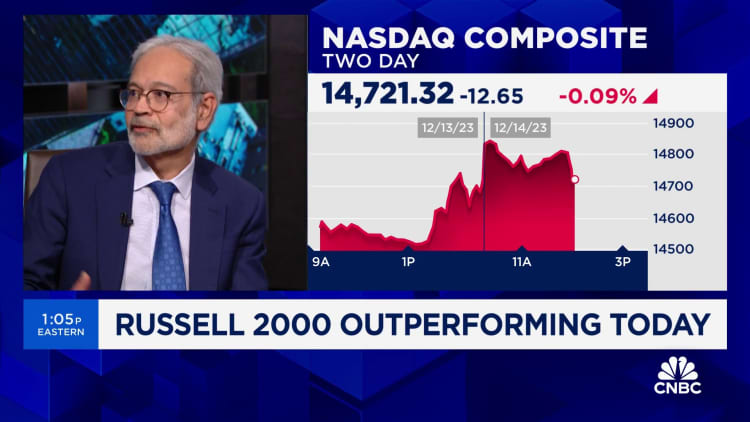Thomas Barwick | Stone | Getty Images
The S&P 500 index has been a winner in 2023.
The index on Wednesday closed above 4,700 for the first time since January 2022. Year to date, the index is up about 23%. Its average annual return is more than 10%.
That performance may now prompt some investors to question whether they should allocate more of their money to a fund that tracks the index.
Vanguard founder John Bogle famously argued long-term wealth may be built by owning a low-cost fund that tracks the stock market, such as the S&P 500.
Per its name, the S&P 500 includes around 500 stocks (503, to be exact) that fall in the large-cap equity category. The index was established in 1957 and was the first market-cap weighted index. That means each company’s weighting in the index is according to its market capitalization, or the total value of all outstanding shares.
The companies included in the S&P 500 is subject to change. This month, ride-hailing company Uber is among several names joining the index, replacing packaging company Sealed Air Corp.
How an S&P 500 ETF can benefit investors
For investors, passive funds that track the index are widely accessible.
“The biggest ETFs in the world are S&P 500 ETFs,” said Bryan Armour, director of passive strategies research for North America at Morningstar, a provider of investment research.
Investors may also choose to add S&P 500-focused mutual funds to their portfolios.
Exchange-traded funds are priced and can be traded throughout the day. Mutual fund orders are typically executed once a day, with all investors receiving the same price.
Another key difference between ETFs and mutual funds is cost.
“Our research has shown over the years that cost is one of the best predictors of future success,” Armour said. “And ETFs are a lot cheaper than mutual funds.”
Passive funds that track an index have the advantage of providing much lower costs than active strategies that are professionally managed. Over time, passive strategies have shown better returns.
“Among the better decisions people can make is starting with an index-based fund tracking the S&P 500 because it works,” said Todd Rosenbluth, head of research at VettaFi.
To be sure, 2023’s strong performance may not be indicative what is to come in 2024.
Will the S&P 500 rally last?
As the calendar turns to the new year, experts are placing bets on where the markets, including the S&P 500, will land.
A recent CNBC Fed Survey found money managers, strategists and economists surveyed expect a modest gain for the S&P 500 in 2024 of less than 2% to reach 4,696. Those experts on average also see the S&P rising above 5,000 for the first time, but not until 2025.
HSBC is expecting the index to reach 5,000 in 2024, with a chance it may go higher if there is no recession.
Raymond James’ S&P 500 target for 2024 is 4,850, due to a more conservative outlook than other firms when it comes to earnings, according to Chief Investment Officer Larry Adam.
That news is based on this year’s good news being already priced into the index, he said.
“Everybody’s feeling better that the Fed is no longer raising rates, they’re going to eventually be cutting rates, inflation is coming down,” Adam said.

In 2024, however, the firm’s forecast includes a mild recession or slower growth.
Much of the S&P 500’s strong turnout this year is due to the so-called “Magnificent Seven,” that includes Alphabet, Amazon, Apple, Meta, Microsoft, Nvidia and Tesla.
Raymond James expects those technology names (excluding Tesla, which it considers a consumer company) to continue to be a driver of the market in 2024, though not as strong as they were this year, Adam said.
“Technology, by far and away, is the one sector that consistently beats its earnings by a fairly substantial amount,” Adam said.
‘Set a strategy and stay invested’
Financial experts generally say investing in an S&P 500 index fund is a sound strategy — though it does leave room for diversification.
“It could prove an effective strategy if you hang on,” said Douglas Boneparth, a certified financial planner and president of Bone Fide Wealth in New York. Boneparth is also a member of the CNBC FA Council.
While the S&P 500 index offers exposure to the largest companies, it excludes small- or mid-size companies, as well as international companies, Boneparth noted.
While buying and holding exposure to the S&P 500 may prove wise over the long term, investors should resist reacting to market moves.
“The main thing would be to set a strategy and stay invested,” David Rea, president of Salem Investment Counselors, which is No. 27 on the 2023 CNBC Financial Advisor 100 list, said via email. “The market is up this year, but down last year. You cannot time the market, so pick funds or ETFs that suit or risk/return profile and stay invested!”
Ted Jenkin, a certified financial planner and CEO and founder of oXYGen Financial, a financial advisory and wealth management firm based in Atlanta, said sticking to low-cost investing and not timing the market may pay off. He is also a member of the CNBC FA Council.
“I don’t think individual investors or money managers can generally outperform the S&P 500,” Jenkin said.

